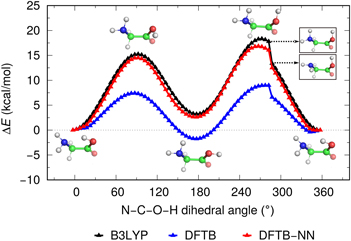Crossref Citations
This article has been cited by the following publications. This list is generated based on data provided by
Crossref.
Irle, Stephan
Vuong, Van Q.
Elayyan, Mouhmad H.
Talipov, Marat R.
and
Abel, Steven M.
2020.
Quantum Mechanics in Drug Discovery.
Vol. 2114,
Issue. ,
p.
149.
Manzhos, Sergei
2020.
Machine learning for the solution of the Schrödinger equation.
Machine Learning: Science and Technology,
Vol. 1,
Issue. 1,
p.
013002.
Eriksen, Janus J.
2020.
Mean-field density matrix decompositions.
The Journal of Chemical Physics,
Vol. 153,
Issue. 21,
Barca, Giuseppe M. J.
Bertoni, Colleen
Carrington, Laura
Datta, Dipayan
De Silva, Nuwan
Deustua, J. Emiliano
Fedorov, Dmitri G.
Gour, Jeffrey R.
Gunina, Anastasia O.
Guidez, Emilie
Harville, Taylor
Irle, Stephan
Ivanic, Joe
Kowalski, Karol
Leang, Sarom S.
Li, Hui
Li, Wei
Lutz, Jesse J.
Magoulas, Ilias
Mato, Joani
Mironov, Vladimir
Nakata, Hiroya
Pham, Buu Q.
Piecuch, Piotr
Poole, David
Pruitt, Spencer R.
Rendell, Alistair P.
Roskop, Luke B.
Ruedenberg, Klaus
Sattasathuchana, Tosaporn
Schmidt, Michael W.
Shen, Jun
Slipchenko, Lyudmila
Sosonkina, Masha
Sundriyal, Vaibhav
Tiwari, Ananta
Galvez Vallejo, Jorge L.
Westheimer, Bryce
Włoch, Marta
Xu, Peng
Zahariev, Federico
and
Gordon, Mark S.
2020.
Recent developments in the general atomic and molecular electronic structure system.
The Journal of Chemical Physics,
Vol. 152,
Issue. 15,
Hourahine, B.
Aradi, B.
Blum, V.
Bonafé, F.
Buccheri, A.
Camacho, C.
Cevallos, C.
Deshaye, M. Y.
Dumitrică, T.
Dominguez, A.
Ehlert, S.
Elstner, M.
van der Heide, T.
Hermann, J.
Irle, S.
Kranz, J. J.
Köhler, C.
Kowalczyk, T.
Kubař, T.
Lee, I. S.
Lutsker, V.
Maurer, R. J.
Min, S. K.
Mitchell, I.
Negre, C.
Niehaus, T. A.
Niklasson, A. M. N.
Page, A. J.
Pecchia, A.
Penazzi, G.
Persson, M. P.
Řezáč, J.
Sánchez, C. G.
Sternberg, M.
Stöhr, M.
Stuckenberg, F.
Tkatchenko, A.
Yu, V. W.-z.
and
Frauenheim, T.
2020.
DFTB+, a software package for efficient approximate density functional theory based atomistic simulations.
The Journal of Chemical Physics,
Vol. 152,
Issue. 12,
Conte, Riccardo
Houston, Paul L.
Qu, Chen
Li, Jeffrey
and
Bowman, Joel M.
2020.
Full-dimensional, ab initio potential energy surface for glycine with characterization of stationary points and zero-point energy calculations by means of diffusion Monte Carlo and semiclassical dynamics.
The Journal of Chemical Physics,
Vol. 153,
Issue. 24,
Stöhr, Martin
Medrano Sandonas, Leonardo
and
Tkatchenko, Alexandre
2020.
Accurate Many-Body Repulsive Potentials for Density-Functional Tight Binding from Deep Tensor Neural Networks.
The Journal of Physical Chemistry Letters,
Vol. 11,
Issue. 16,
p.
6835.
Wang, Zifeng
Ye, Shizhuo
Wang, Hao
He, Jin
Huang, Qijun
and
Chang, Sheng
2021.
Machine learning method for tight-binding Hamiltonian parameterization from ab-initio band structure.
npj Computational Materials,
Vol. 7,
Issue. 1,
Kurban, Hasan
and
Kurban, Mustafa
2021.
Rare-class learning over Mg-doped ZnO nanoparticles.
Chemical Physics,
Vol. 546,
Issue. ,
p.
111159.
Posenitskiy, Evgeny
Spiegelman, Fernand
and
Lemoine, Didier
2021.
On application of deep learning to simplified quantum-classical dynamics in electronically excited states.
Machine Learning: Science and Technology,
Vol. 2,
Issue. 3,
p.
035039.
Kurban, Hasan
2021.
Atom classification with Machine Learning and correlations among physical properties of ZnO nanoparticle.
Chemical Physics,
Vol. 545,
Issue. ,
p.
111143.
Shuaibi, Muhammed
Sivakumar, Saurabh
Chen, Rui Qi
and
Ulissi, Zachary W
2021.
Enabling robust offline active learning for machine learning potentials using simple physics-based priors.
Machine Learning: Science and Technology,
Vol. 2,
Issue. 2,
p.
025007.
Xu, Jiayan
Cao, Xiao-Ming
and
Hu, P.
2021.
Accelerating Metadynamics-Based Free-Energy Calculations with Adaptive Machine Learning Potentials.
Journal of Chemical Theory and Computation,
Vol. 17,
Issue. 7,
p.
4465.
Kalinin, Sergei V.
Ziatdinov, Maxim
Hinkle, Jacob
Jesse, Stephen
Ghosh, Ayana
Kelley, Kyle P.
Lupini, Andrew R.
Sumpter, Bobby G.
and
Vasudevan, Rama K.
2021.
Automated and Autonomous Experiments in Electron and Scanning Probe Microscopy.
ACS Nano,
Vol. 15,
Issue. 8,
p.
12604.
Gómez-Flores, Claudia L.
Maag, Denis
Kansari, Mayukh
Vuong, Van-Quan
Irle, Stephan
Gräter, Frauke
Kubař, Tomáš
and
Elstner, Marcus
2022.
Accurate Free Energies for Complex Condensed-Phase Reactions Using an Artificial Neural Network Corrected DFTB/MM Methodology.
Journal of Chemical Theory and Computation,
Vol. 18,
Issue. 2,
p.
1213.
Teng, Chong
Wang, Yang
Huang, Daniel
Martin, Katherine
Tristan, Jean-Baptiste
and
Bao, Junwei Lucas
2022.
Dual-Level Training of Gaussian Processes with Physically Inspired Priors for Geometry Optimizations.
Journal of Chemical Theory and Computation,
Vol. 18,
Issue. 9,
p.
5739.
Cong, Yang
Zhai, Yu
Chen, Xin
and
Li, Hui
2022.
The Accuracy of Semi-Empirical Quantum Chemistry Methods on Soot Formation Simulation.
International Journal of Molecular Sciences,
Vol. 23,
Issue. 21,
p.
13371.
Fan, Guozheng
McSloy, Adam
Aradi, Bálint
Yam, Chi-Yung
and
Frauenheim, Thomas
2022.
Obtaining Electronic Properties of Molecules through Combining Density Functional Tight Binding with Machine Learning.
The Journal of Physical Chemistry Letters,
Vol. 13,
Issue. 43,
p.
10132.
Pham, Cong Huy
Lindsey, Rebecca K.
Fried, Laurence E.
and
Goldman, Nir
2022.
High-Accuracy Semiempirical Quantum Models Based on a Minimal Training Set.
The Journal of Physical Chemistry Letters,
Vol. 13,
Issue. 13,
p.
2934.
Bowman, Joel M.
Qu, Chen
Conte, Riccardo
Nandi, Apurba
Houston, Paul L.
and
Yu, Qi
2022.
The MD17 datasets from the perspective of datasets for gas-phase “small” molecule potentials.
The Journal of Chemical Physics,
Vol. 156,
Issue. 24,


